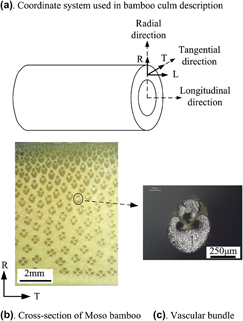Crossref Citations
This article has been cited by the following publications. This list is generated based on data provided by
Crossref.
Huang, Fengling
and
Guo, Wanlin
2013.
Structural and mechanical properties of the spines from Echinocactus grusonii cactus.
Journal of Materials Science,
Vol. 48,
Issue. 16,
p.
5420.
Xu, Qingfeng
Harries, Kent
Li, Xiangmin
Liu, Qiong
and
Gottron, Jennifer
2014.
Mechanical properties of structural bamboo following immersion in water.
Engineering Structures,
Vol. 81,
Issue. ,
p.
230.
Lee, Po-Hua
Odlin, Marty
and
Yin, Huiming
2014.
Development of a hollow cylinder test for the elastic modulus distribution and the ultimate strength of bamboo.
Construction and Building Materials,
Vol. 51,
Issue. ,
p.
235.
Wang, Xiaoqing
Keplinger, Tobias
Gierlinger, Notburga
and
Burgert, Ingo
2014.
Plant material features responsible for bamboo's excellent mechanical performance: a comparison of tensile properties of bamboo and spruce at the tissue, fibre and cell wall levels.
Annals of Botany,
Vol. 114,
Issue. 8,
p.
1627.
Hebel, Dirk E.
Javadian, Alireza
Heisel, Felix
Schlesier, Karsten
Griebel, Dragan
and
Wielopolski, Mateusz
2014.
Process-controlled optimization of the tensile strength of bamboo fiber composites for structural applications.
Composites Part B: Engineering,
Vol. 67,
Issue. ,
p.
125.
Shang, Lili
Sun, Zhengjun
Liu, Xing’e
and
Jiang, Zehui
2015.
A novel method for measuring mechanical properties of vascular bundles in moso bamboo.
Journal of Wood Science,
Vol. 61,
Issue. 6,
p.
562.
SATO, Motohiro
TANIGAKI, Toshiyuki
SATO, Yuka
SHIMA, Hiroyuki
and
INOUE, Akio
2016.
OPTIMAL STRUCTURAL PROPERTIES OF CYLINDRICAL STRUCTURES LEARNING FROM MORPHOLOGY OF WILD BAMBOOS WITH PECULIAR NODES AND VASCULAR BUNDLES.
Journal of Japan Society of Civil Engineers, Ser. A2 (Applied Mechanics (AM)),
Vol. 72,
Issue. 2,
p.
I_25.
Ma, Xinxin
Liu, Xianmiao
Jiang, Zehui
Fei, Benhua
and
Wang, Ge
2016.
Flexural creep behavior of bamboo culm (Phyllostachys pubescens) in its radial direction.
Journal of Wood Science,
Vol. 62,
Issue. 6,
p.
487.
Liu, Huanrong
Wang, Xiaoqing
Zhang, Xiubiao
Sun, Zhengjun
and
Jiang, Zehui
2016.
In situ detection of the fracture behaviour of moso bamboo (Phyllostachys pubescens) by scanning electron microscopy.
Holzforschung,
Vol. 70,
Issue. 12,
p.
1183.
Masselter, Tom
Haushahn, Tobias
Fink, Samuel
and
Speck, Thomas
2016.
Biomechanics of selected arborescent and shrubby monocotyledons.
Beilstein Journal of Nanotechnology,
Vol. 7,
Issue. ,
p.
1602.
Palombini, Felipe Luis
Kindlein, Wilson
de Oliveira, Branca Freitas
and
de Araujo Mariath, Jorge Ernesto
2016.
Bionics and design: 3D microstructural characterization and numerical analysis of bamboo based on X-ray microtomography.
Materials Characterization,
Vol. 120,
Issue. ,
p.
357.
Fei, Benhua
Gao, Zhimin
Wang, Jin
and
Liu, Zhijia
2016.
Secondary Xylem Biology.
p.
283.
Toki, Wataru
Pham, Hong Thai
and
Togashi, Katsumi
2016.
Relationship Between Mandibular Asymmetry, Oviposition Hole, and Oviposition Substrate Hardness in Two Bamboo-Using Lizard BeetlesDoubledaya tonkinensisandD. sinuata(Coleoptera: Erotylidae: Languriinae).
Annals of the Entomological Society of America,
Vol. 109,
Issue. 6,
p.
850.
Awoyera, Paul O.
and
Adesina, Adeyemi
2017.
Encyclopedia of Renewable and Sustainable Materials.
p.
326.
Li, Wen-Tao
Long, Yue-Ling
Huang, Jun
and
Lin, Yan
2017.
Axial load behavior of structural bamboo filled with concrete and cement mortar.
Construction and Building Materials,
Vol. 148,
Issue. ,
p.
273.
Akinlabi, Esther Titilayo
Anane-Fenin, Kwame
and
Akwada, Damenortey Richard
2017.
Bamboo.
p.
1.
Sato, Motohiro
Inoue, Akio
Shima, Hiroyuki
and
Batchelor, Warren
2017.
Bamboo-inspired optimal design for functionally graded hollow cylinders.
PLOS ONE,
Vol. 12,
Issue. 5,
p.
e0175029.
Harries, Kent A.
Bumstead, James
Richard, Michael
and
Trujillo, David
2017.
Geometric and material effects on bamboo buckling behaviour.
Proceedings of the Institution of Civil Engineers - Structures and Buildings,
Vol. 170,
Issue. 4,
p.
236.
Salvati, E.
Brandt, L.R.
Uzun, F.
Zhang, H.
Papadaki, C.
and
Korsunsky, A.M.
2018.
Multiscale analysis of bamboo deformation mechanisms following NaOH treatment using X-ray and correlative microscopy.
Acta Biomaterialia,
Vol. 72,
Issue. ,
p.
329.
Zhao, Xiaoyu
Wang, Guannan
and
Wang, Yanzheng
2018.
Micromechanical modeling in determining the transverse elastic moduli and stress distributions of bamboo.
Journal of Materials Science,
Vol. 53,
Issue. 4,
p.
2553.





